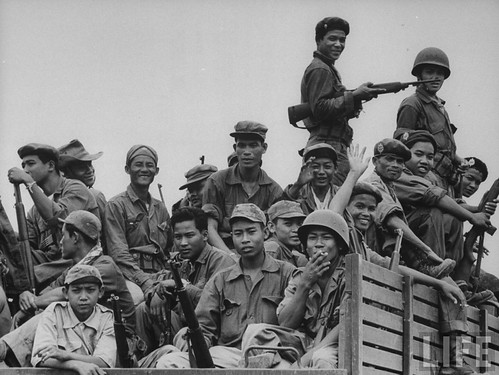 The Laotian Civil War (1959-1975) was a Vietnam proxy conflict that left 40,000 dead. Officially uninvolved, the CIA recruited an army of hill tribesmen to fight the North Vietnamese and Lao communists while making Laos the most bombed country in history. It was not enough. By 1975 Laos was the last of the Asian dominoes to fall.
The Laotian Civil War (1959-1975) was a Vietnam proxy conflict that left 40,000 dead. Officially uninvolved, the CIA recruited an army of hill tribesmen to fight the North Vietnamese and Lao communists while making Laos the most bombed country in history. It was not enough. By 1975 Laos was the last of the Asian dominoes to fall.
In 1953 the French colony of Laos, a thinly populated and landlocked backwater situated between Thailand and Vietnam, gained its independence. The French transferred power to the old royal family, who established the Kingdom of Laos.
 Like Cambodia and South Vietnam, a Marxist insurgency threatened Laos. The North Vietnamese Army invaded in the 1950s to support the Pathet Lao, a local communist group. The Ho Chi Minh Trail, which supported the insurgency in South Vietnam, flowed through Lao territory. Heavily backed by North Vietnamese troops and Soviet and Chinese arms, the Pathet Lao sought to overthrow the Lao monarchy and establish a socialist state.
Like Cambodia and South Vietnam, a Marxist insurgency threatened Laos. The North Vietnamese Army invaded in the 1950s to support the Pathet Lao, a local communist group. The Ho Chi Minh Trail, which supported the insurgency in South Vietnam, flowed through Lao territory. Heavily backed by North Vietnamese troops and Soviet and Chinese arms, the Pathet Lao sought to overthrow the Lao monarchy and establish a socialist state.

The Royal Lao Government was weak in comparison. Despite American support, they could not match the Communists’ numbers or determination. Internal division and low morale beset them.
From 1964, the CIA conducted a ‘Secret War’ on Washington’s behalf. While the 1962 Geneva Convention obliged foreign powers to respect Lao neutrality, North Vietnam ignored it and the USA only pretended. They never officially stationed troops in Laos and never declared war. Using $3.3 billion a year, the CIA outsourced operations to Hmong militias and Air America. Their base at Long Tieng housed 40,000 people, was Laos’s second-biggest city and one of the world’s busiest airports, but appeared in no Atlas and officially did not exist. In fighting this Secret War, the CIA hoped to divert North Vietnamese manpower and halt the spread of communism.
 The main strategy was aerial bombardment. From bases in allied Thailand, American planes bombed communist territory daily. The CIA dropped two million tons of explosives on Laos from 1964-73, an average of one planeload every eight minutes. More explosives were dropped on Laos than Germany and Japan in WW2 combined. Today unexploded ordinance still kills an average of 300 Laotians a year. The American public was kept in the dark.
The main strategy was aerial bombardment. From bases in allied Thailand, American planes bombed communist territory daily. The CIA dropped two million tons of explosives on Laos from 1964-73, an average of one planeload every eight minutes. More explosives were dropped on Laos than Germany and Japan in WW2 combined. Today unexploded ordinance still kills an average of 300 Laotians a year. The American public was kept in the dark.
As the Royal Lao Army proved ineffective, CIA operatives trained and equipped a ‘Secret Army’ of 20,000 Hmong militiamen under major-general Vang Pao. An ethnic minority from the mountains, the Hmong proved capable fighters; rescuing downed American pilots and matching communist guerrillas at their own game. A further 20,000 Thai mercenaries assisted. With 60% of Hmong men serving in the Secret Army, the CIA turned a blind eye to opium trafficking and child soldiery in their ranks.

In 1973 President Nixon made peace with North Vietnam and abruptly ended US involvement in Laos. Abandoned by their allies, the royalists resisted for another two years alone before they surrendered on the 2nd December 1975, eight months after the fall of Saigon. The Indochina Wars had come to an end.
The Pathet Lao established a one-party dictatorship and exacted brutal reprisals against the royalists and the Hmong, whom they promised to wipe out. 300,000 of Laos’s 4 million people, including a third of the Hmong and 90% of the intelligentsia, fled Laos by the 1980s. Thousands of others suspected of working with the Americans and the old regime were sentenced to ‘re-education camps’. The royal family were worked to death.
See Also:

Pingback: Khun Sa and the Burmese Opium Trade | From the Parapet
This is very helpful for my history day project. From TRooney
LikeLike
Glad I could help!
LikeLike
Yup 👍 TRooney
LikeLike
How would I know if the people in the world were related to me?? From TRooney
LikeLike
Sorry I meant war
LikeLike
The war was only one or two generations ago. I suppose by asking older people in your family?
LikeLike
My parents said I was related to Vang Pao. (The commander). I’m half Hmong
LikeLiked by 1 person
Wow, small world. I understand why you would be interested in this topic!
LikeLike
Would you be able to help me find some research for my project? Can you give me links and websites so I don’t fail my project for next week
LikeLike
I can’t remember what sources I used but I had a quick look. Try these:
https://www.economist.com/books-and-arts/2017/01/21/americas-secret-war-in-laos
http://legaciesofwar.org/about-laos/secret-war-laos/
https://www.readex.com/blog/apocalypse-laos-america-loses-laotian-civil-war-communists
LikeLike
Thank you so much! this was very helpful for me
LikeLike
I made it to regionals!! Thank u
LikeLiked by 1 person
That’s really great to hear, congratulations and good luck! Glad you found my post helpful.
LikeLike